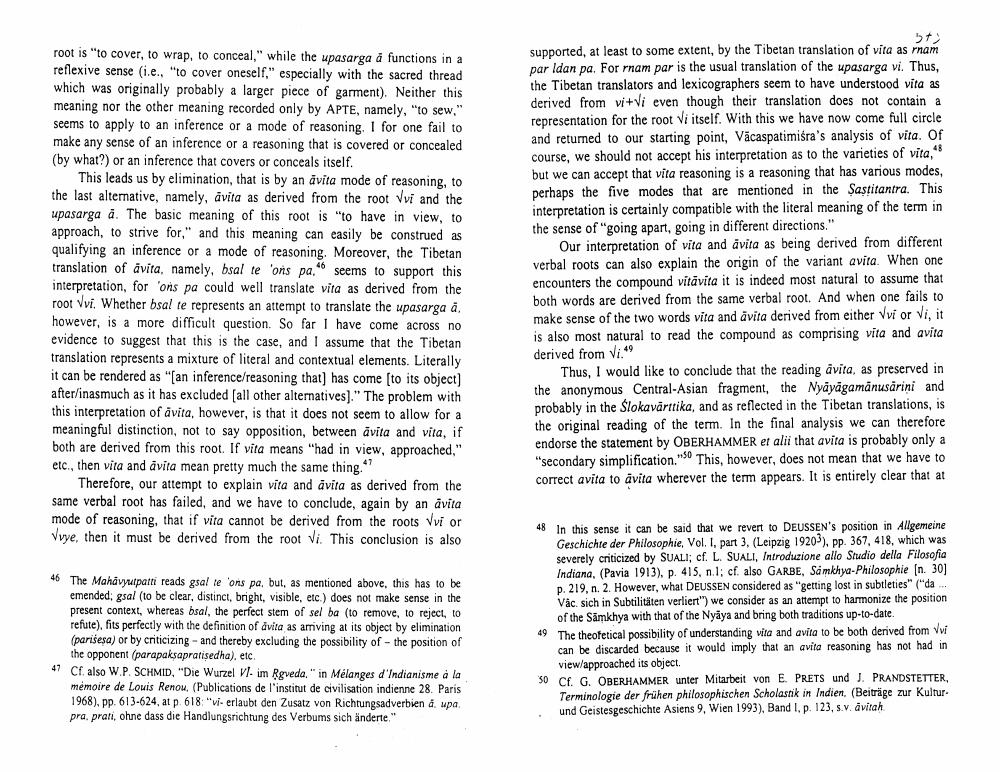Book Title: Avita And Avita Author(s): Eli Franco Publisher: Eli Franco View full book textPage 7
________________ root is "to cover, to wrap. to conceal," while the upasarga å functions in a reflexive sense (i.e., "to cover oneself," especially with the sacred thread which was originally probably a larger piece of garment). Neither this meaning nor the other meaning recorded only by APTE, namely, "to sew." seems to apply to an inference or a mode of reasoning. I for one fail to make any sense of an inference or a reasoning that is covered or concealed (by what?) or an inference that covers or conceals itself. This leads us by elimination, that is by an avita mode of reasoning, to the last alternative, namely, avita as derived from the root Vvi and the upasarga å. The basic meaning of this root is "to have in view, to approach, to strive for," and this meaning can easily be construed as qualifying an inference or a mode of reasoning. Moreover, the Tibetan translation of avita, namely, bsal te 'ons pa." seems to support this interpretation, for 'ons pa could well translate vita as derived from the root vi. Whether bsal te represents an attempt to translate the upasarga á however, is a more difficult question. So far I have come across no evidence to suggest that this is the case, and I assume that the Tibetan translation represents a mixture of literal and contextual elements. Literally it can be rendered as "an inference/reasoning that) has come to its object) after/inasmuch as it has excluded (all other alternatives)." The problem with this interpretation of avita, however, is that it does not seem to allow for a meaningful distinction, not to say opposition, between avita and vita, if both are derived from this root. If vita means "had in view, approached," etc., then vita and avita mean pretty much the same thing." Therefore, our attempt to explain vita and avita as derived from the same verbal root has failed, and we have to conclude, again by an avita mode of reasoning, that if vita cannot be derived from the roots Vvi or Vvye, then it must be derived from the root Vi. This conclusion is also supported, at least to some extent, by the Tibetan translation of vita as rnam par Idan pa. For rnam par is the usual translation of the upasarga vi. Thus, the Tibetan translators and lexicographers seem to have understood vita as derived from vi+Vi even though their translation does not contain a representation for the root Vi itself. With this we have now come full circle and returned to our starting point. Väcaspatimisra's analysis of vita. Of course, we should not accept his interpretation as to the varieties of vita," but we can accept that vita reasoning is a reasoning that has various modes, perhaps the five modes that are mentioned in the Şastitantra. This interpretation is certainly compatible with the literal meaning of the term in the sense of "going apart, going in different directions." Our interpretation of vita and avita as being derived from different verbal roots can also explain the origin of the variant avita. When one encounters the compound vitāvita it is indeed most natural to assume that both words are derived from the same verbal root. And when one fails to make sense of the two words vita and avita derived from either Vvi or vi, it is also most natural to read the compound as comprising vita and avita derived from Vi." Thus, I would like to conclude that the reading avita, as preserved in the anonymous Central-Asian fragment, the Nyāyāgamānusarini and probably in the Slokavårttika, and as reflected in the Tibetan translations, is the original reading of the term. In the final analysis we can therefore endorse the statement by OBERHAMMER et alii that avita is probably only a "secondary simplification. This, however, does not mean that we have to correct avita to avita wherever the term appears. It is entirely clear that at 46 The Mahavyutpatti reads gsal te 'ons pa, but, as mentioned above, this has to be emended, gsal (to be clear, distinct, bright, visible, etc.) does not make sense in the present context, whereas bsal, the perfect stem of sel ba (to remove, to reject to refute), fits perfectly with the definition of vita as amving at its object by elimination (parisesa) or by criticizing - and thereby excluding the possibility of the position of the opponent (parapaksapratisedha), etc. 47 Cf also W.P. SCHMID, "Die Wurzel VI. im Rgveda," in Mélanges d'Indianisme à la mémoire de Louis Renou. (Publications de l'institut de civilisation indienne 28. Paris 1968), pp. 613-624, at p. 618: "vi- erlaubt den Zusatz von Richtungsadverbien dupa pra, prati, ohne dass die Handlungsrichtung des Verbums sich änderte." 48 In this sense it can be said that we revert to DEUSSEN's position in Allgemeine Geschichte der Philosophie, Vol. I, part 3. (Leipzig 1920), pp. 367, 418, which was severely criticized by SUALI; cf. L. SUALI, Introduzione allo Studio della Filosofia Indiana. (Pavia 1913), p. 415, n.1cf. also GARBE, Samkhya-Philosophie (n. 30) p. 219, n. 2. However, what DEUSSEN considered as "getting lost in subtleties" ("da .. Vác, sich in Subtilitäten verliert") we consider as an attempt to harmonize the position of the Samkhya with that of the Nyaya and bring both traditions up-to-date. 49 The theofetical possibility of understanding vita and avita to be both derived from vvi can be discarded because it would imply that an avita reasoning has not had in view/approached its object. 50 Cf. G. OBERHAMMER unter Mitarbeit von E. PRETS und J. PRANDSTETTER, Terminologie der frühen philosophischen Scholastik in Indien. (Beiträge zur Kulturund Geistesgeschichte Asiens 9, Wien 1993), Band I. p. 123, s.v. avitahPage Navigation
1 ... 5 6 7 8
